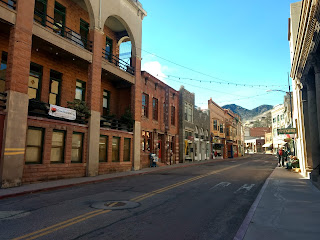Today was a really good day! I would place it on the top best 50 days of my life, because I got to move a 160 ton, 107 inch wide telescope just with the touch of my finger.
But let's wind back to the beginning. The McDonald observatory is located 48 miles north of Marfa just after Fort Davis. We were supposed to visit Fort Davis, but it was closed because of the government shut down. It was an old fort operational from 1854 to 1891, to protect the emigrants going from San Antonio to El Paso from Comanche attacks.
So off we went to the observatory, which sits on top of Mount Locke in the Davis Mountains, and it is part of the University of Texas at Austin. We knew of this observatory from the Star Date program on NPR and the warm voice of Sandy Wood. I was hoping to meet her, but at the reception they told me that she is really lives in Austin at the university.


We enrolled in every possible tour for the day. In fact, around here, you really have to plan your visit because many sites are open only three out of seven days a week.
So I learned a bunch of stuff. I am going to write it down here as I understood it ....
The nebula is a dense 'cloud' of gases that twirl around until they concentrate so much that a star (or stars) is formed. That's why nebula are called star nurseries.
The sun does not have a magnetic field like the earth because portions of its surface rotate at different speeds causing the magnetic field to become wound many times around. This causes the creation of many small magnetic fields that shoot plasma out from one pole and catches it from an other. These small magnetic fields cover the sun surface. The surface of the sun looks like boiling water due to the convection of heat from the core to the cooler surface, and then back down to the core. Sometimes the magnetic fields are so wound up, that the don't allow the plasma to go down again so they cool off from 9000°F to 6000°F and become sun spots (because they shine less). Some magnetic fields are even more wound up like a rubber band ball that they explode popping their cap and shooting out plasma into space. Sometimes the earth is at the right position to be a target, but luckily our super awesome magnetic field protects us and dissipates the rays like the Enterprise shield in Star-trek. At the earth poles some of the lower level radiation makes it in and causes the aurora borealis. What else? Oh yeah! One of these days (it happens every 150 years) there will be a flare that is so big that our shield will be powerless and it will wipe out all our electrical grids, generators and everything that has current running through. Get ready!
Then I got to drive the super ginormous telescope, the Harlan J. Smith Telescope.

Then we went to see the latest and greatest, the 10-meter wide Hobby–Eberly Telescope (HET). This is made of 91 hexagonal segments, and because of this design the cost was greatly reduced. The telescope does not move like the others. The giant composite mirror rotates and the surface is analyzed at the focus by instrumentation that moves on a rail and around. You can't get pretty views of stars with this telescope, it only provides spectroscopic data. In fact they told us that 50% of astronomical research nowadays is in spectroscopy. Their latest big project is to determine what is causing the universe to expand. To do this the telescope repeatedly captures millions of data points in the sky and all this information is analyzed in software. They told us that half the scientists involved in the project are software engineers. They will also use this equipment in the search for earth-like exoplanets.
The twilight presentation was more for family, but nonetheless it made you think about stuff that I never busied my mind to ponder. For example, Mercury, the planet closest to the sun, has an orbit of 88 days, while Mars' is 2 years and Jupiter 12 years. That causes Jupiter to be in a different zodiac sign every year. In fact the zodiac signs are lined up in the celestial vault and they become visible to our eyes according to the month. Also from earth we get to see Mercury and Venus only at dusk and dawn. Why? Because they are always behind us at night when we look away from the sun, since they are closest to the sun. Neat hey?
It was a cloudy day, and the Star Party was a pooper; well not completely. We got to have a nice presentation by a real astronomer (I forgot his name). He showed us the constellations and various objects that we could see at the Star Party as we were waiting for the clouds to clear out. And they did! So we went out in the bitter cold and we got to see through the dome telescopes and other fancy telescopes: Mars, the Orion Nebula, Andromeda galaxy, the Pleiades 7 stars cluster and Messier 15 globular cluster.
The cherry on top was a spectrometer demonstration. I am almost glad it was cloudy.
We were given special glasses to look through a light source. This tool separated the light in the different colors like a prism. We saw the different patterns of light color according to the element. For example hydrogen is only three vertical lines. We were able to identify the element contained in an unknown light source. Very cool! I freakin' love science!

















































